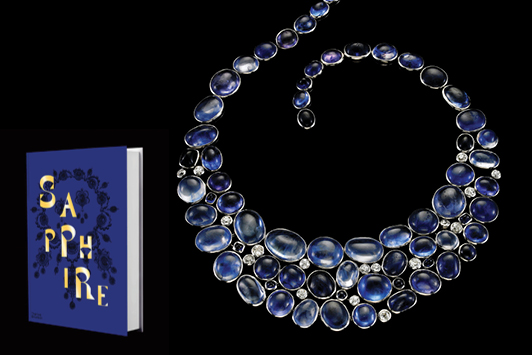
A member of the corundum gemological family, sapphire is second only to diamond in its hardness, which makes it possible to carve into cameos and intaglios. Its crystals are often larger than those of a ruby or emerald, meaning the stone can be cut into large shapes for impressive jewels. And it naturally occurs in a range of colors, from deepest blue, green and grey to yellow, orange, pink and purple, notes gemologist and fine-jewelry specialist Joanna Hardy in her new book,
Sapphire: A Celebration of Colour.
Having tackled emerald and ruby in previous books, Hardy completes her trilogy of the “big three” gemstones with this informative tome. She spent 10 years traveling the globe while writing the trio of books, most recently visiting sapphire deposits in Madagascar — the biggest producer of sapphires since they were discovered there in 1998, she notes.
Since antiquity, she writes, “sapphires have been discovered in Sri Lanka (Ceylon), Myanmar (Burma), Cambodia, Thailand, Vietnam, Ethiopia and France,” with later discoveries during the 20th century in Kashmir, Australia, and Montana in the US. She begins her book by talking about the traders along the famed Silk Road and maritime Silk Route, and ends by discussing mining in Australia’s outback, Myanmar, Kashmir, Madagascar, Montana, Scotland and Sri Lanka. The color photos that accompany her narrative offer readers an armchair tour of jewels from some of the greatest museums and collections worldwide.
Matrimony and devotion
Many have attributed healing, restorative and protective powers to sapphires. The gemstone’s most common color, blue, has a lot to do with it, the book points out. Associations with the sea, the endless horizon and the sky have linked it to the heavens and to divine power, as is evident from sapphire’s use in religious objects, crowns, and ceremonial jewels.
In the language of gemstones, sapphires stand for constancy, explains Hardy. Britain’s Prince Albert designed and commissioned sapphire jewelry for Queen Victoria, including a brooch he gave her before their wedding.
As a symbol of royal love and “devotion in matrimony,” the book states, sapphire has featured in many royal bridal jewels. In Britain, the list is long, beginning in 1923 with the sapphire and diamond ring Elizabeth Bowes-Lyon — later Queen Elizabeth, the queen mother — received on her wedding from future King George VI. In 1947, the king gave his daughter, then Princess Elizabeth, a sapphire and diamond necklace and earrings, made circa 1850, for her wedding. In 1963, a matching new sapphire and diamond tiara and bracelet joined those pieces.
Perhaps the most famous British-royal engagement ring in recent years is the sapphire and diamond cluster ring that Prince Charles gave to then-Lady Diana Spencer in 1981. The ring passed down to her son, Prince William, who gave it in 2010 to his bride-to-be, Catherine Middleton. In 2018, Jack Brooksbank proposed to Princess Eugenie with a padparadscha sapphire ring.
Hollywood stars of the 1930s — America’s answer to royalty — also chose sapphires for their wedding jewelry. Fittingly, the stone of choice tended to be the star sapphire. Jewelers such as Paul Flato, Raymond C. Yard, Trabert & Hoeffer-Mauboussin, Oscar Heyman & Brothers, and Fulco di Verdura created pieces for these silver-screen brides, who wore their gems long after their marriages fizzled. Among them was Carole Lombard, who received a large star sapphire engagement ring from fellow actor William Powell. Actress Jean Harlow also received a sapphire ring from Powell after his divorce from Lombard. Actress Mary Pickford’s ring from Douglas Fairbanks, Sr., featured the 181.82-carat, violet-blue Star of Bombay star sapphire, which was actually from Sri Lanka. The marriage didn’t last, but Hardy relates that Pickford held onto the ring, bequeathing it on her death to the Smithsonian Institution in Washington, DC.
Designer timeline
The book explores sapphire-adorned jewelry from some of the most famous luxury houses, including Chaumet’s tiaras; Cartier’s tutti frutti jewels, such as the show-stopping Collier Hindou it made for heiress Daisy Fellowes; a mystery-set sapphire and diamond bracelet by Van Cleef & Arpels; and the Montana sapphires in Tiffany & Co’s creations.
Hardy also talks about the influence of three women on French maisons. Jeanne Boivin continued her husband René’s business after his death in 1917, hiring Suzanne Belperron, writes Hardy. Jeanne Toussaint was artistic director at Cartier Paris in 1933 and continued to oversee fine-jewelry production for the next four decades. And Renée Puissant, who became artistic director of Van Cleef & Arpels in 1926, worked with designer René Sim Lacaze to build the firm’s design legacy.
Legendary jewelry collectors wearing their sapphire treasures in the book include Elizabeth Taylor, Marjorie Merriweather Post and Duchess of Windsor Wallis Simpson. A look at designers creating 21st-century sapphire jewels rounds out the tome.
Sapphire: A Celebration of Colour by Joanna Hardy will be published by Thames & Hudson in October.
Article from the Rapaport Magazine - September 2021. To subscribe click here.